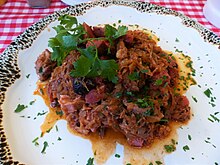Bigos

Bigos [ ˈbiɡɔs ] is a cabbage stew made from steamed sauerkraut with different types of meat and sausage as well as other varying ingredients. Considered the epitome of classic Polish cuisine , it is primarily a national dish in Poland , but for historical reasons it is also used in Lithuania (Lithuanian name: Bigoss ), Belarus (Belarusian Бігас Bigas ) and (especially western) Ukraine (Ukrainian Бігос Bigos ) an integral part of the local kitchens.
etymology
Where the name of the dish comes from is controversial. There are three common variants.
Variant 1: from Italian
One theory says that the word could come from the old Italian word bigutta , which means cauldron or soup pot .
Variant 2: from Latin
The word bigos could come from Latin. So it should have come from bigustus with bi for two and gustus for taste . This is interpreted in terms of the sweet and sour tastes that are combined in one. Another interpretation is that it could mean mixing sauerkraut and fresh white cabbage.
Variant 3: from the German
A popular assumption is that it can be traced back to the old German word Beiguss from the 16th century . It should come from the fact that liquid has to be constantly added (basting) when cooking.
The court
The basic ingredients of the dish are sauerkraut, white cabbage and - in different quantities - pork and / or beef and various types of sausage and spices that are cooked over low heat. The slow cooking means that the high-fat meat and sausage ingredients give off their fat to cabbage and cabbage. Depending on the region, occasion and preferences as well as the presence of ingredients, Bigos is varied many times, so that there is no fixed recipe. Among others, mushrooms , prunes , tomatoes or tomato paste , carrots , onions , bacon , juniper , bay leaf and allspice mitgegart. There are also spicy variations with paprika and sour cream . Bread or potatoes are served with bigos, depending on the region and preference . Hardly found today, hot water used to be added and the dish was eaten as a soup.
Traditionally, bigos put more meat than cabbage in the pot. It is common to use cabbage, bacon and meat in a ratio of 1: 1: 1. The mix may vary depending on availability. In general, bigos take a long time to prepare. Repeated heating over two to three days improves the taste sustainably. The effort of preparation over several days is rarely carried out today, but it is crucial for the taste. In Poland, bigos is usually part of the standard range of restaurants specializing in Polish cuisine or Polish milk bars and is also often offered by snack stands in addition to sausage products. In the meantime, it can also be found in some Western European countries at larger fairs and festivals .
history
Even if historians consider the court to be much older, the court was first mentioned in the 15th century. From then on it became popular all over Poland-Lithuania , mainly because of its long shelf life . It is not known where exactly this dish comes from, nor have recipes - unlike other traditional Polish dishes - been written down. Due to the size of the country, the multicultural society and the different preferences associated with it, many variants emerged. The partition of Poland at the end of the 18th century also contributed to the fact that no uniform recipe could prevail. No other dish was found in so many poetry. For example, in Pan Tadeusz it says:
“W kociołkach bigos grzano. W słowach wydać trudno. Bigosu smak przedziwny, kolor i woń cudną: Słów tylko brzęk usłyszy i rymów porządek; Ale treści ich miejski never pojmie żołądek. "
“Bigos was cooked in the kettle. It's hard to put into words. The taste so strange, the color and the smell so wonderful: words are just a buzz and the rhymes a coincidence; but only the stomach will understand the content. "
literature
- Igor Jurjewitsch Klech : The book about food. Pelmeni and pierogi, borscht and bigos & Co. From the Russian and with an afterword by Tatjana Hofmann. Edition.fotoTapeta, Berlin 2011, ISBN 978-3-940524-12-6 .
- Christine Haiden : Bigos & Baklava. Life stories and recipes from the new Europe. Verlag Welt der Frau, Linz 2003, ISBN 3-9501580-1-4 .
Web links
Footnotes
- ↑ Andrzej Bankowski: Etymologiczny słownik języka polskiego. 83-01-13016-4.
- ↑ Historia bigosu. (No longer available online.) December 4, 2013, archived from the original on February 1, 2014 ; Retrieved January 25, 2014 (Polish).
- ↑ Bigos. In: Dziennik Polski. February 4, 2013, accessed January 25, 2014 (Polish).
-
↑ Witold Doroszewski (Ed.); Polska Akademia Nauk (ed.): Indeks a tergo do Słownika języka polskiego. (= Słowník języka polskiego , Volume 1). Państwowe Wydawnictwo Naukowe, 1958, p. 518 (Polish);
see also: Thomas Menzel, Gerd Hentschel u. a .: Dictionary of German loanwords in the Teschen dialect of Polish. Library and information system of the University of Oldenburg, Oldenburg (Oldb) 2003, ISBN 3-8142-0857-9 , p. 14 (Quote: "... a dish made from sauerkraut and meat. Etym. Nhd. Pouring water over it."). - ^ Klaus Roth (Ed.): Neighborhood. Intercultural relations between Germans, Poles and Czechs. Waxmann, Münster 2001, ISBN 3-8309-1039-8 , p. 266.
